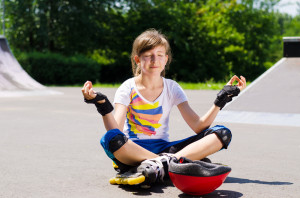 “Mindfulness is a mental state achieved by focusing one’s awareness on the present moment, while calmly acknowledging and accepting one’s feelings, thoughts, and bodily sensations. We will learn meditation skills that can help us to be relaxed and aware. These skills can help with test taking, sports, and social situations. Meditation can be wonderful and effective but you have to take the training seriously.”
“Mindfulness is a mental state achieved by focusing one’s awareness on the present moment, while calmly acknowledging and accepting one’s feelings, thoughts, and bodily sensations. We will learn meditation skills that can help us to be relaxed and aware. These skills can help with test taking, sports, and social situations. Meditation can be wonderful and effective but you have to take the training seriously.”
What you just read is the description for a new class I get to offer this year! Let me explain. All our teachers have packed schedules. Not only do I teach a total of four and a half hours of humanities a day, I also facilitate a twenty-five minute social and emotional curriculum, along with a one hour physical education class that flip-flops with something we call Student Interest Groups. The last hour of every day is dedicated to either physical education or student interests. This model allows for students to have a lot of learning time in their core classes (which correlate with state as well as common core standards), and allows faculty to design their own courses based on teacher passions and student interests. Yes, it’s more work to design your own course, however, the future return on this investment can be awesome.
I committed myself to introducing my own peaceful routine to fifteen wide-eyed sixth, seventh, and eighth graders, (these classes can also be much smaller than core classes because all faculty teaches at the same time). I made sure to model what I expected them to do as soon as they sat down. Before even discussing what mindfulness is we challenged ourselves with sitting still and listening. I signaled the start of silence with a singing bowl, an item whose vibratory qualities have an almost magical effect. (click this link to view a brief demonstration on how to play a singing bowl)
Some kids placed a hand on their stomachs to monitor their breath. Although the whole process took several minutes, I set the tangible goal of just thirty seconds of silence and stillness. When the bowl sounded off again, I inquired about what they experienced. When any subject is being taught it is invaluable to acknowledge the experiences of the students afterwards. One of the younger kids told us that she could hear her own heart beating, while an eighth grader said that she held her breath the whole time. “Interesting…” was my non-judgmental response to both.
While planning this class I searched the web for kid friendly resources. I found a few gems and shared this one during my opening class: Teaching Mindfulness To Children At Home And In Schools. The kids all seemed, if not intrigued, at least respectful of the scenarios the cartoon presented. The video opened the door for a discussion about why to meditate. I discovered there were athletes, dancers, conscientious test takers, anxiety prone kids, and just plain curious truth seekers who hoped that this practice could help them with their endeavors.
Before class ended I introduced them to the term “drop in” and asked them to do so. Spines straightened, eyes closed, and the singing bowl worked its magic. This last time we sat for forty-five seconds, and it seemed that at least two children didn’t want it to end.
Our final challenge was to bring mindfulness to action. I challenged everyone to put up all the chairs without disturbing the peaceful environment we had created together. I am thankful for the opportunity to offer a whole class dedicated to “dropping in”, especially for the kids who are looking for the same help I received.
Nicholas Philliou, 7th grade humanities teacher in Durango, Colorado













Leave a Reply